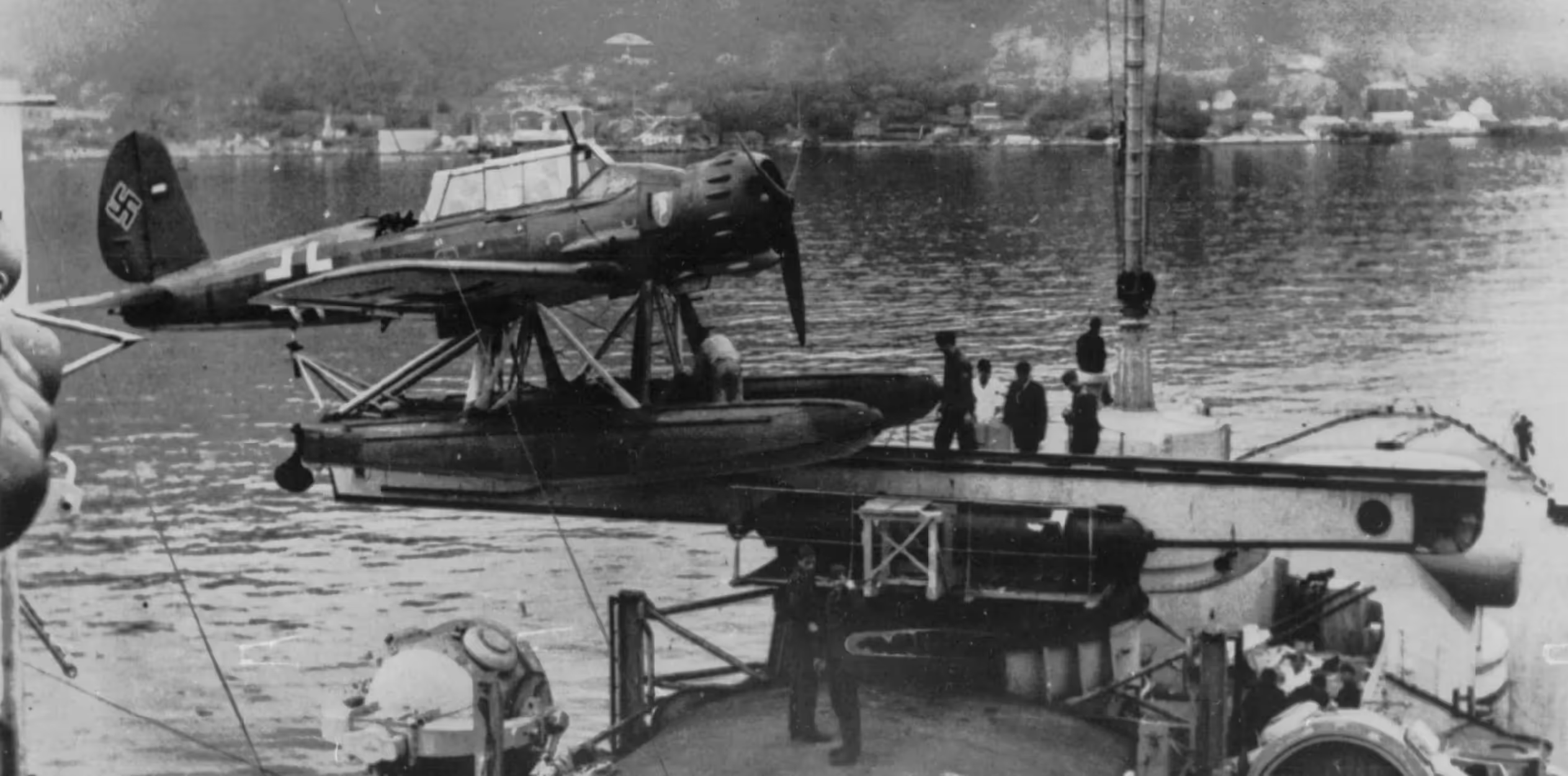Warplanes of Germany: Luftwaffe Arado Ar 196A
Arado Ar 196A

(Kriegsmarine Photo)
Arado Ar 196A-3, coded T3+AH, being loaded onto the German cruiser Admiral Graf Spee.
The Arado Ar 196 was a shipboard reconnaissance low-wing monoplane aircraft designed and produced by the German aircraft manufacturer Arado. It was the standard observation floatplane of the Kriegsmarine (German Navy) throughout the Second World War, and was the only German seaplane to serve throughout the conflict. (Wikipedia)

(Kriegsmarine Photo)
Arado Ar 196A.

(Kriegsmarine Photo)
Arado Ar 196A.

(Kriegsmarine Photo)
Arado Ar-196A before being lunched Norway, 11 Jul 1940.
The Arado Ar 196A was a Luftwaffe two-seat coastal patrol and light attack aircraft powered by one BMW 312K nine-cylinder radial air-cooled piston engine. It had a top speed of 194-mph, a cruising speed of 166-mph, service ceiling of 22,965’, and a range of 497 miles. Loaded, it had a weight of 7,282 lbs. It had a wingspan of 40’ 10”, a length of 35’ 11-1/2” and a height of 14’7”. It was armed with two wing-mounted 20-mm MG FF cannon with 60 rpg plus one 7.9-mm MG 17 machinegun in the starboard side of the forward fuselage and one 7.9-mm MG 15 on a flexible mounting with 525 rpg; plus one ETC 50/VIII rack underneath each wing for a single 110-lb SC 50 bomb.
The Ar 196A was loved by its pilots, who found it handled well both in the air and on the water. The first Arado Ar 196A to fall into allied hands was an example belonging to the German heavy cruiser KMS Admiral Hipper captured in Lyngstad by a Norwegian Marinens Flyvebaatfabrikk M.F. 11 seaplane of the Trødelag naval district on 8 April 1940 at the beginning of the Norwegian campaign. It was flown against its former owners with Norwegian markings. On 18 April 1940 it was flown to the UK by a Royal Norwegian Navy Air Service pilot. Not long afterwards the plane crashed while being flown by a British pilot while in transit to the Helensburgh naval air base for testing. At the end of the war, at least one other Ar 196A was left at a Norwegian airfield and kept in use as a liaison aircraft by the Royal Norwegian Air Force for a year on the West Coast.

(RAF Photo)
Arado Ar 196A-5 (Wk. Nr. 1960514), ship-borne reconnaissance/coastal patrol floatplane, captured at Schleswig, Germany in May 1945. Designated RAF AM92 (VM761), this aircraft was scrapped at Felixstowe in the UK in 1947. One of the captured Ar 196A seaplanes was flown by RCAF S/L Ian Somerville.
Arado Ar 196A, (Wk. Nr .unknown), captured at Schleswig. Designated RAF AM90, this aircraft was scrapped at Schleswig.
Arado Ar 196A-5, (Wk. Nr. 127), captured at Schleswig. Designated RAF AM91, this aircraft was scrapped at Felixstowe in 1947.
Arado Ar 199A-0, (Wk. Nr. unknown), captured at Schleswig. Designated RAF AM93, this aircraft was scrapped at Schleswig.

(Vislupus Photo)

(Peter Meneely Photo)
Arado Ar 196A-3, ship-borne reconnaissance/coastal patrol floatplane. This aircraft was operated by the Bulgarian Air Force. It is displayed at the Bulgarski Vozdushni Voiski Muzeum (Museum of Aviation and the Air Force), Plovdiv, Bulgaria.
Only three Ar 196A floatplanes still exist from the total production run of 526 aircraft, excluding the prototypes and pre-production aircraft. Ar 196A-3 (Werk-Nummer 75526), coded as “White 3” (Serial No. 0219), is on display in the Bulgarski Vozdushni Voiski Muzeum in Plovdiv, Bulgaria, with Bulgarian insignia. This Ar 196A-3 is one of twelve the Bulgarian Navy operated during the Second World War from Varna on the coast.
Ar 196A-5, (Wk. Nr. 623167) coded +HG, T3+BH, belongs to the National Air & Space Museum. The Allies recovered two Ar 196A-5s found on board the German battlecruiser Prinz Eugen when she surrendered at Copenhagen, Denmark.
Ar 196A-5, (Wk. Nr. 623183) coded T3+CH is the second of these two aircraft, and is being restored by the U S Naval Aviation Museum in Pensacola, Florida.
The Norwegian Historical Museum in Sola, Norway, has the fuselage frame of an Ar 196A-2 raised from the sunken German battleship Blücher.
When the US Navy took custody of Prinz Eugen, they were more interested in the catapult system used to launch the floatplane rather than the Ar 196A-5 but they saved the two aircraft anyway. The Ar 196A-5, (Wk. Nr. 623167) in the NASM has only 14 hours of operational flying time and U S Navy pilots added just four more hours during testing and evaluation at the Naval Air Materiel Center in Philadelphia, Pennsylvania. The US Navy evidently repainted the airplane with markings copied from a different aircraft. That floatplane bore the code letters GA+DX (Wk. Nr. 68967). Today, the National Air & Space Museum‘s Ar 196A-5 still carries the bogus paint and markings of GA+DX. After years in storage, the Navy transferred the airplane to the Museum in 1961, where it is now preserved.
Both of the Arado Ar 196A-5 floatplanes were recovered from the German cruiser Prinz Eugen by American forces survive. Arado Ar 196A-5 (Wk. Nr. 623167) is in storage at the Paul E. Garber Facility of the Smithsonian's National Air and Space Museum, and awaiting restoration. Ar 196A-5 (Wk. Nr. 623183) was stored with the National Museum of Naval Aviation (NMNA) at Pensacola, Florida. This aircraft is currently on loan to the Aeronauticum Museum at Nordholz, Germany.

(Björn Atterberg Photo)
Arado Ar 196A-3 (Wk. Nr. 1003), parts stored in a Swedish Air Force Museum.

(Kriegsmarine Photo)
Arado Ar 196, ship-borne reconnaissance/coastal patrol floatplane.

(Kriegsmarine Photo)
Arado Ar-196A3 floatplane is being moved on a wheeled dolly and towed by a tractor.





